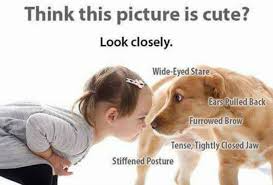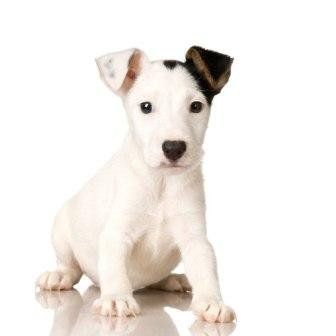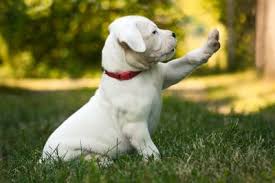These are quite scary statistics, with an underlying theme stating that most dog bite incidents occur within the home and the dog is known to the victim.
I cannot comment on every dog bite that has occurred but the ones I am aware of often involve a dog that has been pushed to their limits by the behaviour of a child that has not been educated in how to interact with a dog.
There are numerous videos on social media showing young children cuddling, climbing on and pulling and poking dogs, with the proud parent (behind the camera) commenting on how cute the situation is when the poor dog is “smiling” or lip licking - clearly stating that they are not happy with the situation. (I cringe every time I see one).
If a human is being treated in this way the human can reason with the child, lift the child off or move away and possibly , if it is another adult doing the pestering, may resort to shouting or , worst case , violence to get away from the situation.
There are some tolerant dogs out there, but dogs do try and communicate in similar ways. They may try and remove themselves; they may give body language signs – “smiling”, lip licking or turning away. If this does not work it may escalate to snarling, barking or growling. If the signs are not read correctly and the dog is pushed this may escalate to a bite as the dog is given no other option to create space.
Unfortunately, young children cannot see and interpret these signs, therefore almost all dog bites on children are as a result of an adult failing to recognise and prevent potential problem situations.
How to avoid a dog bite.
Dog/Child interactions
Toddlers.
The toddler ages are the most difficult for child/dog relationships. The toddler is mobile, noisy and old enough to get to the dog but not old enough to know how to correctly interact with dogs. The sudden erratic movements and high-pitched noises of a toddler can cause your dog to become over excited or fearful – therefore, it is important to monitor interactions carefully:
- Control and supervise all interactions between children and your dog.
- Do not let children ambush or force themselves on to a dog.
- If the dog does not want to come forward and interact do not force the issue – give the dog some space, get the child to ignore the dog and allow the dog time to get used to the child and come forward of their own accord.
- Give the dog their own space – Give the dog an area where he/she can be put or can retreat to if he/she wants a time out away from the child. Explain to the children the importance of leaving the dog alone in this area.
- Do not have the dog/puppy with you constantly. As humans we need time to relax, this is just as important for dogs. If your child is too young to understand that the dog is relaxing the use of a baby gate or door may be needed to block their access to the dog.
- Toddlers and young children often encourage puppies to chase and play bite. This is largely due to the child’s movements, energy and sounds that they make which excite the situation. If one or the other gets over excited, separate the two to give them time to calm down and never leave them alone to interact together (no matter how short a period. It takes a split second for a dog to bite and cause injuries. Remember - the dog in most incidents is trying to create space and get away).
- Older children and adults can also be over excitable and inconsistent in their approach towards puppies. i.e. winding the puppy up one minute then getting angry with it when it gets over excited the next.
- Teach the children that the dog is not a soft toy and should be left alone when relaxing or sleeping and not picked up roughly and carried around or cuddled on laps constantly.
- Most dogs and puppies do not like face to face contact. It is important to educate children of this fact. A large amount of bites reported in the Press highlight the fact that the child (or adult in some cases) received injuries to the face or head – reading between the lines this is an indicator that the victim put their face to close to the dogs face.
One case that I have personally dealt with was of a young dog biting a visitor to the house. On meeting him, the visitor cuddled him on the sofa, taking hold of his head and tried to kiss him. This resulted in a bite to the girls’ face and an injury resulting in hospitalisation and many stitches.
Many Dogs enjoy interacting with children and will tolerate a high level of rough handling, but it is important to set limits:
- Reading books to children about animals can help them to empathise with pets.
- Lead by example – show your child how to interact – when your child is watching, gently stroke the dog and play with it calmly all the while talking in a soft calm voice.
- As your child gets older, you may want to involve them in the daily care of the dog. Maybe your child can be taught to feed the dog or help groom and brush – all the time being supervised by yourselves.
- Learn about dog body language and read and act on the signs. I have uploaded some information sheets on dog body language at the end of this blog which you are more than welcome to refer to. There are many signs that dogs give, some to look out for are; - The Dog turning its head away and /or trying to get away, wide eyes, lip – licking, “Smiling” – lips drawn back exposing teeth.
Situations which can cause problems
Understanding what can cause a dog to bite a child is quite simple. The situations can be similar to situations or actions that can drive a human (or parent) to need a break from or to tell the children off.
- I personally do not like it if someone tries to steal food (especially my Sunday Roast) off my plate. Or they try to put their hands on my plate. Dogs are the same – they like their food and want to eat in peace.
- We try to educate children to play with respect for the other person and to not steal or snatch toys from them. It can also be deemed as rude behaviour to snatch a toy from a dog, especially if the dog is possessive about the toy. Children should be taught that unless they are having supervised play, they should leave the dogs toys alone. They should be taught that they can only take the toy if the dog willingly gives the toy up, and if possible, by exchanging it for a treat or another toy. Adults can reinforce this tolerance in a dog by training a dog to leave a toy using the same method of exchanging for a treat or another toy.
- I do not like people getting to close to me or in my face, but sometimes young children cannot help but exhibit this behaviour and must be taught about social distance. This can be irritating to a dog as can “kisses” or taking hold of the dog’s face, especially when the dog cannot get away or control the situation.
- Most people do not like to be disturbed when they are relaxing or sleeping – dogs are the same, they need down time to chill out and relax. Ideally a dog should have a safe location that they can retreat to or be put in to get away from excitable children or an over excitable situation such as a child’s Birthday Party. If the dog comes out of their own free will then that OK, but if he wants to be left alone then he should be.
- Dogs generally do not enjoy rough handling such as hugging, pulling, jumping or siting on, riding and grabbing. It is possible to train dogs (especially as puppies) to enjoy and accept close handling such as hugging in order to help avoid accidents, but it is better to teach children to interact with a dog calmly and politely and to understand that a strange dog may not be as receptive to this type of attention as their own dog.
- Loud noises such as children screaming, slamming doors, dropping items etc. can put humans on edge – the same can happen to dogs.
- Once a child understands the basics of interacting with their pet, it possible to teach the child fun games to build on that basic interaction. For example, if you have a dog that loves to chase and retrieve and willingly gives the toy up then this would be a suitable game.
- Exercise is a fantastic way for a child to bond with a dog. Sharing experiences in the outside world and playing games such as hide and seek is great way for both child and dog to have fun.
No matter how good the relationship is and how tolerant the dog, it is essential that all interactions are supervised by an adult and the child and dog are never left alone together.
How to introduce your child to your dog or your dog to a child.
The introduction of a new baby into a household can really upset a dog’s routine. there are several steps that you can take and implement so it is not such a shock for your dog when you bring baby home:
- Teach your dog not to jump up. Implement four feet on the floor rule – the dog does not get any interaction (attention, fuss, treats etc.) unless they have, and keep, four feet on the floor.
- Teach your dog basic commands such as sit, stay and come in order to help with control of the dog around baby.
- Get your dog used to a new routine before the baby comes home. This might be restricting his access round the house, not allowing him on the sofa, only allowing him in certain rooms, not giving him as much attention as he is used to. If there are areas of the house that you do not want your dog to go into when you bring your baby home, such as the nursery, get the dog used to this change as soon as possible, in order to avoid any conflicting messages.
- Teach your dog to settle behind a baby gate or crate using treats, praise or interactive toys like stuffed Kong's, to make it a positive experience. This will help if you are focusing on the baby, but the dog will not feel segregated and can still see what is going on.
N.B. a good idea is that once you have a Nursery set up, before baby comes home, allow your dog to inspect it then install a baby gate and begin using it or close the door so your dog doesn't have free access to the room.
- Get your dog used to the sights, sounds and smells of a baby. This may include getting him used to walking beside a pram or getting used to you carrying a bundle around in your arms. A good idea is to purchase/borrow a child’s doll, ideally one that makes baby noises and practice carrying the baby, changing its nappy etc. so these new behaviours of yours become the norm before baby comes home.
- Ensure that your dog’s worming, vaccinations and flea treatments are all up to date.
Bringing baby home.
- If possible, before baby comes home, take some of your babies clothing or a blanket home so the dog gets the chance to smell the baby before the baby comes home.
- When coming home, mum should greet the dog first (without baby) for the dog to get any excitable greeting out of their system. Once the dog has settled bring baby in making sure there is at least one adult present to help control dog. Keep this initial introduction a quiet event. Having a bunch of relative’s waiting to greet you as well can make your dog more nervous or excitable.
- Try not to make a big thing of having baby and dog in the room at the same time. Reward the Dog for remaining calm (with gentle praise, treats etc.) and do not shout or get angry at them if they get it wrong. It is the parent’s responsibility to teach the dog how to behave.
- Never leave baby and dog alone together or put baby and dog on the same level such as on the floor, side by side on the sofa etc.
Bringing a new dog home.
Bringing a new dog home whether it is a puppy, or an older rescue dog is like bringing home a baby.
The dog will need an area that is out of the way and quiet so they can be out there to relax and settle. If you have young children in the house your child should not have free access to this area.
Establish a clear set of boundaries that everyone consistently applies from day 1 so the dog understands what he can and cannot do.
Interactions should always be supervised, especially in the first few months.
In the first 3 days your dog will be overwhelmed with their surroundings and may not be comfortable enough to show their true character.
After 3 weeks he will be starting to settle in, feeling more comfortable and may start to show his true character.
After 3 months your dog should be fully settled in.







